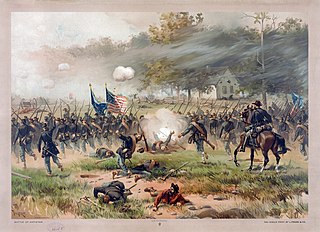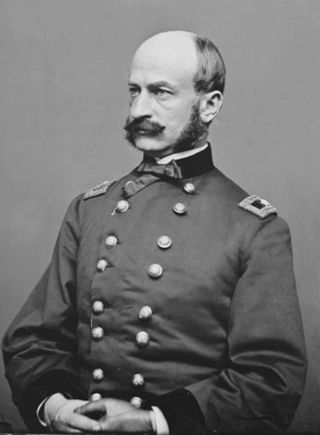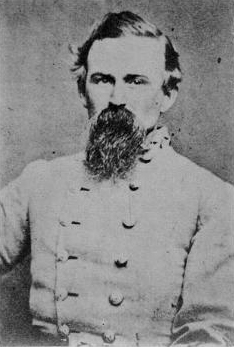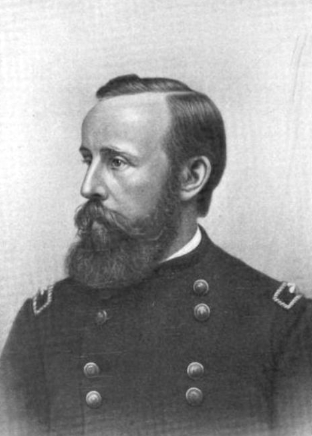
The Battle of Antietam, also called the Battle of Sharpsburg, particularly in the Southern United States, took place during the American Civil War on September 17, 1862, between Confederate General Robert E. Lee's Army of Northern Virginia and Union Major General George B. McClellan's Army of the Potomac near Sharpsburg, Maryland, and Antietam Creek. Part of the Maryland Campaign, it was the first field army–level engagement in the Eastern Theater of the American Civil War to take place on Union soil. It remains the bloodiest day in American history, with a tally of 22,727 dead, wounded, or missing on both sides. Although the Union Army suffered heavier casualties than the Confederates, the battle was a major turning point in the Union's favor.

The Army of the Potomac was the primary field army of the Union army in the Eastern Theater of the American Civil War. It was created in July 1861 shortly after the First Battle of Bull Run and was disbanded in June 1865 following the surrender of the Confederate Army of Northern Virginia in April.

The XI Corps was a corps of the U.S. Army during the American Civil War, best remembered for its involvement in the battles of Chancellorsville and Gettysburg in 1863. The corps was composed primarily of German-American regiments.
The XII Corps was a corps of the Union Army during the American Civil War.

The Maryland campaign occurred September 4–20, 1862, during the American Civil War. The campaign was Confederate General Robert E. Lee's first invasion of the North. It was repulsed by the Army of the Potomac under Maj. Gen. George B. McClellan, who moved to intercept Lee and his Army of Northern Virginia and eventually attacked it near Sharpsburg, Maryland. The resulting Battle of Antietam was the bloodiest day of battle in American history.

Evander McIver Law was an author, teacher, and a Confederate general in the American Civil War.

Baron Adolph Wilhelm August Friedrich von Steinwehr was a German-Brunswick army officer who emigrated to the United States, became a geographer, cartographer, and author, and served as a Union general in the American Civil War.

Joseph King Fenno Mansfield was a career United States Army officer and civil engineer. He served as a Union general in the American Civil War and was mortally wounded at the Battle of Antietam.

John Curtis Caldwell was a teacher, a Union general in the American Civil War, and an American diplomat.

George Henry Gordon was an American lawyer and a Union general in the American Civil War.

George Pierce Doles was an American businessman and Confederate general during the American Civil War. His men played a key role on the first day of the Battle of Gettysburg in driving back the Union XI Corps.

Charles Candy was a career soldier in the United States Army who served as an officer in the volunteer Union Army during the American Civil War. He commanded an Ohio regiment and, frequently, a brigade, during the war, and played a role in the defense of Culp's Hill during the July 1863 Battle of Gettysburg.

Ezra Ayers Carman was an officer in the Union Army during the American Civil War, commanding a New Jersey infantry regiment and (occasionally) a brigade.

Ariovistus Pardee Jr. was an officer in the Union Army during the American Civil War. He rose to fame during the Battle of Gettysburg, where he led the defense of a portion of Culp's Hill on July 3, 1863. A monument on the Gettysburg Battlefield commemorates the spot as "Pardee Field."
Henry J. Stainrook, occasionally spelled Steinrock, led a regiment of the Army of Virginia and the Army of the Potomac in the American Civil War. He briefly led a brigade at the Battle of Antietam. Stainrook was killed in the Battle of Chancellorsville.

The 5th Ohio Infantry Regiment was an infantry regiment from southwestern Ohio that served in the Union Army during the American Civil War, serving in both the Eastern and Western Theaters in a series of campaigns and battles. It was noted for its holding the high ground at the center of the line at Antietam as part of Tyndale's 1st Brigade, Greene's 2nd Division of Mansfield's XII Corps.

Sumner Carruth was an officer in the volunteer army of the United States during the American Civil War. He commanded the 35th Massachusetts Volunteer Infantry and eventually rose to the command of two different brigades in the IX Corps.

Edward Harland was a Union general during the American Civil War. He was associated with early battles of the IX Corps as well as Union involvement in North Carolina and the Tidewater region of Virginia.

The 125th Pennsylvania Infantry volunteered during the American Civil War and served a 9-month term from August 1862 to May 1863. It selected the motto In God We Trust. The Regiment fought at the Battle of Antietam under the leadership of Colonel Jacob C. Higgins less than six weeks after being recruited in Blair, Cambria and Huntingdon Counties. The Regiment was noted for its charge through the East Woods, along the Great Cornfield, down Smoketown Road, past the Dunker Church, and into the West Woods. While in formation beyond the Dunker Church in an 'overextended' position, the Regiment repulsed four counterattacks at a price of 229 casualties within 20 minutes. A fifth, heavily reinforced Confederate counterattack forced a retreat with a desperate struggle to retain the Regimental colors. Two weeks before the end of their enlistment, the 125th Pennsylvania also occupied the perimeter of Chancellorsville, Virginia, during the Battle of Chancellorsville.

The 28th Pennsylvania Volunteer Infantry was an infantry regiment that served in the Union Army during the American Civil War. It was noted for its holding the high ground at the center of the line at Antietam as part of Tyndale's 1st Brigade, Greene's 2nd Division of Mansfield's XII Corps.

















